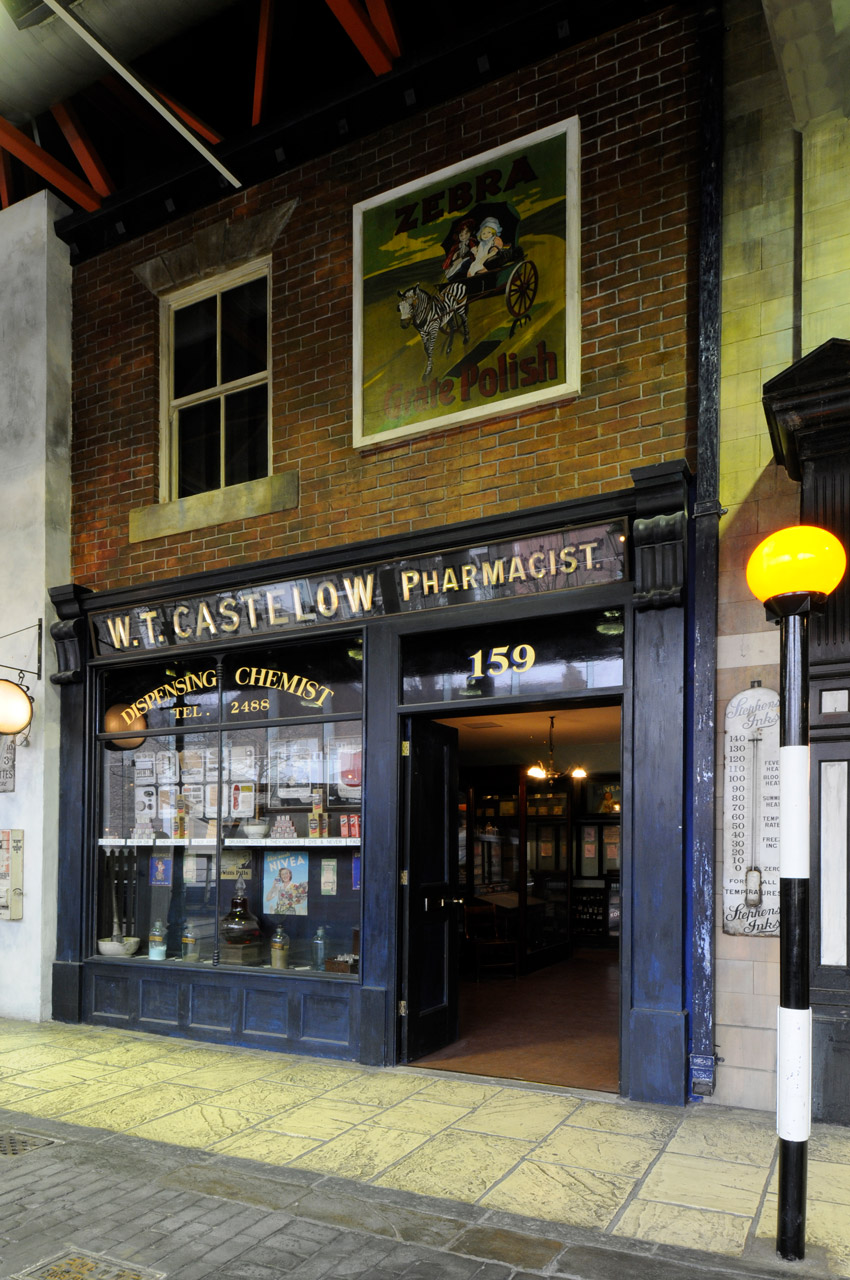The Chemist Shop
A visit to Streetlife Museum isn't complete without a stroll along our street scene. There you'll find The Chemist Shop – a unique part of our collections.
The Chemist Shop is an exact reconstruction of a Yorkshire chemist that once stood at 159 Woodhouse Lane, Leeds. There for 133 years, the shop now has a second life among our collections. Here it offers visitors a glimpse into the fascinating era of Victorian medicine.

The chemist shop at 159 Woodhouse Lane
Mr Walter Thomas Castelow's shop at 159 Woodhouse Lane was the oldest surviving chemist shop in Leeds. 133 years old to be precise! That was until the redevelopment of the local university saw the shop demolished in 1976.
Opening in 1841 under the name Bentley's, the shop had a long history. It later operated as Dearden's, then Brown's, before coming into Castelow's hands in 1907. Over the course of the twentieth century, the world outside changed a great deal. But the little shop held on to its Victorian character.
A true original
By the 1970s, many of the shop's original 1840s fittings remained. The sturdy mahogany counter. The drug run. The glass-fronted cabinets, showcases and shelves. Gilt-labelled jars. Coloured bottles. And huge glass rounds containing liquids, powders, tablets and pills. Castlelow used all these things right up until he died in 1974.
Like his shop, Mr Castelow's appearance was unique. Throughout his life, he wore the smart, professional dress of his Edwardian youth. Instead of a modern white lab coat, he opted for a waistcoat, jacket and cravat, complete with a stiffly-starched two-inch collar. Castlelow struck an imposing figure to be sure, but his warm smile quickly put people at ease.
Traditional Remedies
During medical consultations, Castlelow often issued traditional remedies over factory-made, branded drugs. He was a true Edwardian chemist, "cooking up" medicines in his house. To concoct the correct preparation he would refer to several sources. His hard leather-bound pharmacopoeia, his handwritten equations and, of course, his Latin notes. Castlelow would pick ingredients by hand from his drug run and shelves. Then grind dried ingredients in a large pestle and mortar. He would measure out syrups, treacles and other liquids with nothing but a steady hand and Victorian glass measures. He could also turn pastes into tablets, suppositories and pills with the use of a Victorian pill-making machine.
Despite increasing restrictions (and the removal of some ingredients under the poisons act!), Castelow still believed in traditional remedies. So did his customers. Some people even travelled the whole country to sample Castelow's curious cures. Customers came hoping for relief from all sorts, from headaches to bronchitis.
From Woodhouse Lane to Streetlife Museum
When Mr Castelow died aged 98, his chemist shop was heading for demolition. Realising the potential loss, Castelow had made one last preparation. His will provided the shop's unique contents be preserved within a Yorkshire museum.
Hull Museums complied with Castelow's wishes. In 1976, a team went out to take detailed photographs of every shelf, drawer, bottle and jar on the premises. The shop was then packed up and transported to Wilberforce House Museum on High Street. It was later rehoused in the more fitting environment of our street scene here at Streetlife Museum.
A faithful reconstruction
We reconstructed the chemist shop exactly as it appeared during Mr Castelow's ownership. Everything down to the smallest detail was replicated – even the shop's distinctive smell. Today, the chemist shop offers an intriguing insight into the Victorian world. The shelves abound with concoctions unobtainable today, such as Blood Purifiers and Liver Rousers. Recognisable brands from the twentieth century stand alongside these more unusual remedies. Together, they show what sorts of ailments have troubled people over the last century. Some of these ailments may sound familiar: headaches, diarrhoea, flu, colds and coughs. Others, such as typhoid, no longer feature so much in modern British life.
A global sensation
During Mr Castelow's ownership, the shop attracted visitors from all over the world. Many people wanted to see a chemist's shop from a different age. The atmosphere was so unique that in the 1960s, an American visitor offered to buy the shop from Castelow. They planned to ship the shop in its entirety to the United States. Castelow politely refused – he was adamant his shop would stay in Yorkshire.
Today, Castlelow's chemist shop continues to be a major attraction and visitor favourite.

